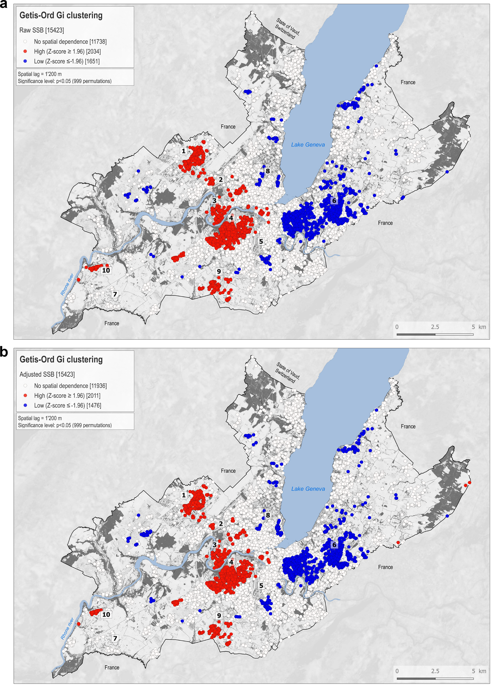当前位置:
X-MOL 学术
›
Nutr. Diabetes
›
论文详情
Our official English website, www.x-mol.net, welcomes your feedback! (Note: you will need to create a separate account there.)
Overlapping spatial clusters of sugar-sweetened beverage intake and body mass index in Geneva state, Switzerland.
Nutrition & Diabetes ( IF 6.1 ) Pub Date : 2019-11-14 , DOI: 10.1038/s41387-019-0102-0 Stéphane Joost 1, 2, 3, 4 , David De Ridder 1, 2, 3, 5 , Pedro Marques-Vidal 3, 6 , Beatrice Bacchilega 1 , Jean-Marc Theler 2 , Jean-Michel Gaspoz 2, 5 , Idris Guessous 2, 3, 5
Nutrition & Diabetes ( IF 6.1 ) Pub Date : 2019-11-14 , DOI: 10.1038/s41387-019-0102-0 Stéphane Joost 1, 2, 3, 4 , David De Ridder 1, 2, 3, 5 , Pedro Marques-Vidal 3, 6 , Beatrice Bacchilega 1 , Jean-Marc Theler 2 , Jean-Michel Gaspoz 2, 5 , Idris Guessous 2, 3, 5
Affiliation

|
BACKGROUND
Obesity and obesity-related diseases represent a major public health concern. Recently, studies have substantiated the role of sugar-sweetened beverages (SSBs) consumption in the development of these diseases. The fine identification of populations and areas in need for public health intervention remains challenging. This study investigates the existence of spatial clustering of SSB intake frequency (SSB-IF) and body mass index (BMI), and their potential spatial overlap in a population of adults of the state of Geneva using a fine-scale geospatial approach.
METHODS
We used data on self-reported SSB-IF and measured BMI from residents aged between 20 and 74 years of the state of Geneva (Switzerland) that participated in the Bus Santé cross-sectional population-based study (n = 15,423). Getis-Ord Gi spatial indices were used to identify spatial clusters of SSB-IF and BMI in unadjusted models and models adjusted for individual covariates (education level, gender, age, nationality, and neighborhood-level median income).
RESULTS
We identified a significant spatial clustering of BMI and SSB-IF. 13.2% (n = 2034) of the participants were within clusters of higher SSB-IF and 10.7% (n = 1651) were within clusters of lower SSB-IF. We identified overlapping clusters of SSB-IF and BMI in specific areas where 11.1% (n = 1719) of the participants resided. After adjustment, the identified clusters persisted and were only slightly attenuated indicating that additional neighborhood-level determinants influence the spatial distribution of SSB-IF and BMI.
CONCLUSIONS
Our fine-scale spatial approach allowed to identify specific populations and areas presenting higher SSB-IF and highlighted the existence of an overlap between populations and areas of higher SSB-IF associated with higher BMI. These findings could guide policymakers to develop locally tailored interventions such as targeted prevention campaigns and pave the way for precision public health delivery.
中文翻译:

瑞士日内瓦州含糖饮料摄入量和体重指数的空间簇重叠。
背景技术肥胖症和与肥胖症有关的疾病代表了主要的公共卫生问题。最近,研究证实了食用糖分饮料(SSBs)在这些疾病的发展中的作用。准确识别需要公共卫生干预的人口和地区仍然具有挑战性。这项研究调查了SSB摄入频率(SSB-IF)和体重指数(BMI)的空间聚类的存在,以及它们在日内瓦州成年人口中使用细度地理空间方法的潜在空间重叠。方法我们使用自我报告的SSB-IF数据,并测量了参加了BusSanté横断面人口研究(n = 15,423)的日内瓦州(瑞士)20至74岁之间的居民的BMI。Getis-Ord Gi空间指数用于在未经调整的模型和针对个体协变量(教育水平,性别,年龄,国籍和居委会水平的中位数收入)进行调整的模型中,确定SSB-IF和BMI的空间聚类。结果我们确定了BMI和SSB-IF的显着空间聚类。13.2%(n = 2034)的参与者在较高SSB-IF的集群内,10.7%(n = 1651)在较低的SSB-IF的集群内。我们确定了在11.1%(n = 1719)的参与者所居住的特定区域中SSB-IF和BMI的重叠集群。调整后,识别出的簇持续存在并且仅略微衰减,这表明其他邻域水平决定因素会影响SSB-IF和BMI的空间分布。结论我们的精细空间方法允许识别出具有较高SSB-IF的特定人群和区域,并强调了与较高BMI相关的较高SSB-IF的人群和区域之间存在重叠。这些发现可以指导政策制定者制定针对当地情况的干预措施,例如有针对性的预防运动,并为精确的公共卫生交付铺平道路。
更新日期:2019-11-14
中文翻译:

瑞士日内瓦州含糖饮料摄入量和体重指数的空间簇重叠。
背景技术肥胖症和与肥胖症有关的疾病代表了主要的公共卫生问题。最近,研究证实了食用糖分饮料(SSBs)在这些疾病的发展中的作用。准确识别需要公共卫生干预的人口和地区仍然具有挑战性。这项研究调查了SSB摄入频率(SSB-IF)和体重指数(BMI)的空间聚类的存在,以及它们在日内瓦州成年人口中使用细度地理空间方法的潜在空间重叠。方法我们使用自我报告的SSB-IF数据,并测量了参加了BusSanté横断面人口研究(n = 15,423)的日内瓦州(瑞士)20至74岁之间的居民的BMI。Getis-Ord Gi空间指数用于在未经调整的模型和针对个体协变量(教育水平,性别,年龄,国籍和居委会水平的中位数收入)进行调整的模型中,确定SSB-IF和BMI的空间聚类。结果我们确定了BMI和SSB-IF的显着空间聚类。13.2%(n = 2034)的参与者在较高SSB-IF的集群内,10.7%(n = 1651)在较低的SSB-IF的集群内。我们确定了在11.1%(n = 1719)的参与者所居住的特定区域中SSB-IF和BMI的重叠集群。调整后,识别出的簇持续存在并且仅略微衰减,这表明其他邻域水平决定因素会影响SSB-IF和BMI的空间分布。结论我们的精细空间方法允许识别出具有较高SSB-IF的特定人群和区域,并强调了与较高BMI相关的较高SSB-IF的人群和区域之间存在重叠。这些发现可以指导政策制定者制定针对当地情况的干预措施,例如有针对性的预防运动,并为精确的公共卫生交付铺平道路。


























 京公网安备 11010802027423号
京公网安备 11010802027423号